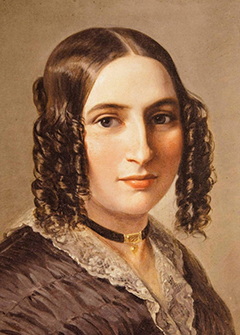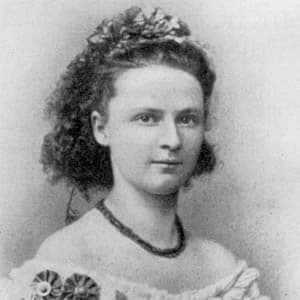
Fanny Mendelssohn © play-images.primephonic.com
We continue with more wonderful cello works by the accomplished women composers of yesteryear who had to grapple with a lack of recognition for their music.
Fanny Hensel, née Mendelssohn (1805-1847) is recognized as an important composer especially of lieder, (art songs). Overshadowed by her talented younger brother, composer Felix Mendelssohn, both of them studied with the finest teachers Berlin could offer. It is said that by the age of 13, she could play all of the J.S. Bach Well-Tempered Clavier from memory. After she married the court painter Wilhelm Hensel in 1829 she organized popular Sunday afternoon salons at the Mendelssohn Berlin home presenting not only the works of Beethoven, Bach, Mozart, and her brother, but also her own compositions—which number 250 lieder, 120 piano pieces, a string quartet, a piano trio, and other works—the attendees among them illustrious musicians such as Franz Liszt and Clara Schumann. Neither Mendelssohn-Hensel’s father nor her brother supported publishing her compositions. She was not recognized as a composer until a few of her early works were published in 1846 with the support of her husband. Sadly, she passed away the following year. Despite composing over 500 compositions, several of her works remain only in manuscript form or were published under her brother’s name. She wrote exquisite short pieces for cello. Another sibling, Paul Mendelssohn, happened to be an excellent cellist, and these challenging cello parts were perhaps written with him in mind. The piano accompaniments are demanding and harmonically rich, romantic, and dramatic in the style of contemporaries such as Brahms.
Fanny Mendelssohn-Hensel: Das Jahr: 12 Characterstucke – No. 2. February (Wolfram Lorenzen, piano)
Listen to Das Jahr (The Year) piano cycle H. 385. Fabulous!
The Capriccio for cello and piano begins subtly and with a tender melody. The introduction is interrupted by a “Sturm und Drang” style section—agitated, breathless, and vehement, then the wistful opening returns to calm us and resolves gently. It’s wonderful writing for the cello. Fantasia in G minor is another gorgeous short piece with moments that remind me of Beethoven’s slow movements. The yearning evinced is achingly beautiful. After an upbeat middle section the tranquility returns briefly, and the piece surprises us with a delightful ending. A composer extraordinaire.
Fanny Mendelssohn-Hensel: Capriccio in A-Flat Major (Nenad Lečić, piano; Katharina Deserno, cello)
Fanny Mendelssohn-Hensel: Fantasia in G Minor (Nenad Lečić, piano; Katharina Deserno, cello)

Louise Farrenc
Louise Farrenc (1804-1875) wrote a beautiful classical Sonata from 1859 for Cello and Piano in B flat, Op 46. Her music was essentially forgotten after her death despite the wonderful career she established as a performer, teacher, and composer. A resurgence of interest in her music is much deserved. Just recently, the San Francisco Symphony with Michael Morgan conductor performed Farrenc’s Symphony No. 3 at Davies Hall. At a very young age it became evident she would have a career as a professional pianist. Her talent was such that at age fifteen her parents allowed her to study with the eminent teachers of the Paris conservatoire, but as a woman she was not to allowed to actually join the class. Her reputation grew as a performer, teacher, editor, and composer even favorably noted by Schumann and Berlioz. In 1842, she was appointed Professor of Piano at the Conservatoire, a position she held for thirty years. In the mid-1800s, her chamber music compositions especially her nonet, four piano trios, virtuosic piano pieces, and two piano quintets, were well-loved and played by eminent performers such as violinist Joseph Joachim. Louise’s husband Aristide, a flautist, believed in her music, and once the couple established Éditions Farrenc, many of Louise’s works were published.
Louise Farrenc: Cello Sonata in B Major, Op. 46 – II. Andante sostenuto (Kirsten Whitson, cello; Mary Ellen Haupert, piano)
The first movement of the cello sonata is charming and full of lovely grace notes and delicate turns of the phrase. The andante sostenuto movement is especially gorgeous—gentle and sustained, in a lilting 6/8 tempo with undulating sixteen notes in the piano. The cello brings sparkle to the finale and taking center stage, the pianist plays nimble and lively passagework demonstrating the influence of Farrenc’s piano teachers, the first, a disciple of Clementi, and later the brilliant composer Johann Nepomuk Hummel. But Farrenc’s dream of having her symphonic works recognized and performed did not come to fruition. Hindered by the societal mores of the time, compounded by the loss of her daughter, Victorine, a talented pianist who passed away at age 32, Farrenc stopped composing. Her last years were spent researching early music and teaching.
Louise Farrenc: Cello Sonata in B Flat Major, Op.46 – III. Finale Allegro

Luise Adolpha Le Beau
German composer Luise Adolpha Le Beau (1850-1927) began as a pianist. She started to compose at the young age of 15. Subsequently she became a teacher, critic, and a performer, her 1868 debut was a resounding success as soloist in Beethoven’s E-flat Piano Concerto and a Mendelssohn Concerto. Le Beau studied with the eminent conductor Hans von Bülow who encouraged her to move to Munich. As a woman, she was not allowed to officially enroll in the Royal Music School. Nonetheless it was a productive time for her as she embarked on concert tours, often performing her own music, she composed, and she wrote reviews as a music critic. In 1882 Le Beau’s Cello Sonata in D, Op. 17, won an international prize. Consequently, her works at last were performed across Europe and even as far as Sydney and Istanbul, unheard of for a female composer! Despite having to move residences many times, and having the responsibility for ailing parents, she composed a piano concerto, a symphonic poem, a string quintet, and an opera. Le Beau withdrew from public performance for several years when she met the singer Alfredo de’ Giorgio at the turn of the century, but she did write her memoirs. Later, after relocating to Baden-Baden, Le Beau returned to music. Le Beau’s compositions comprise an impressive number of pieces for piano, violin, cello, and viola, a piano trio, a piano quartet, a string quartet, a string quintet, as well as orchestral music, choral music, and lieder. Le Beau’s Cello Sonata is another one I think ought to be standard repertoire. Effortlessly lyrical and Mendelssohn-like, the colorful harmonies, and delicate touch is uplifting. The andante tranquillo second movement with a ravishing melody features the tender side of the cello. The composer returns to the sunny, stirring lines in the last movement allegro vivace. It’s a virtuosic and dazzling movement. Le Beau wrote several short cello pieces, Wiegenlied, Mazurka, Gavotte, and a gorgeous Romanze, which would be ideal for an encore.
I’ve just scratched the surface. In the next article, we’ll feature several more women composers whose music I know you’ll enjoy.
For more of the best in classical music, sign up to our E-Newsletter
Luise Adolpha Le Beau: 4 Pieces for Cello and Piano, Op. 24 – No. 1. Romanze in E Major: Massig bewegt (Thomas Blees, cello; Maria Bergmann, piano)
Luise Adolpha Le Beau: Cello Sonata in D Major, Op. 17 – I. Allegro molto (Thomas Blees, cello; Maria Bergmann, piano)
Luise Adolpha Le Beau: Cello Sonata in D Major, Op. 17 – II. Andante tranquillo (Thomas Blees, cello; Maria Bergmann, piano)




Thank you Janet for good information.
And thank you so much for your books. Just prescribed for a student who is one big knot. !!
And thank you for writing. Im very pleased you are using my book as a reference and that you enjoyed this article.
I’d love to know where to find these wonderful pieces. IMSLP doesn’t have most of them! Is there an archive where they’re available?
Hi Jim are you a cellist? If so I recommend the International Cello Society Facebook group which is a terrific resource and they often respond to questions like these! Either someone has the music or access to the music. Some libraries have the pieces. I’d also check with the UNCG Greensboro NC cello archives.
Thanks for commenting.
Thank you–I hadn’t come across Fanny Hensel’s cello pieces before. I’ve been boosting her works for years, especially her Piano Trio, String Quartet, and some of her songs. These pieces have the same sort of extraordinary intensity as so many of her other works.